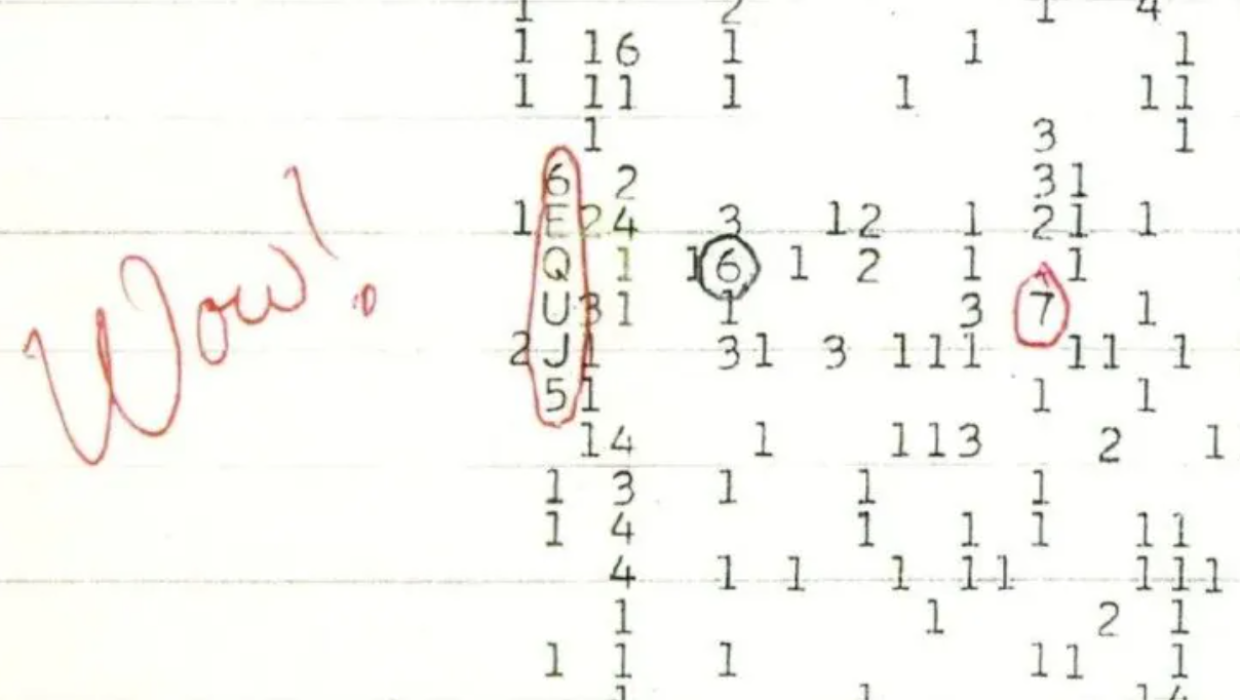Science
Scientists Pinpoint Natural Source of 1977 Alien Radio Signal

A radio signal detected in 1977, once deemed a potential sign of extraterrestrial life, has likely been traced back to a natural origin, according to a team of scientists. The signal, dubbed the “Wow! signal” after the enthusiastic note written by astronomer Jerry R. Ehman upon its discovery, was captured by the Big Ear radio telescope at Ohio State University and has puzzled researchers for decades.
In a recent study published in the journal Astronomy & Astrophysics, researchers from the University of California, Berkeley have provided new insights into the signal’s origin. Their analysis suggests that the Wow! signal likely emanated from a hydrogen cloud located approximately 180 light-years away in the constellation Sagittarius. This finding marks a significant shift in the narrative surrounding the signal, which has captivated imaginations since its initial reception.
Decoding the Wow! Signal
The Wow! signal was detected on August 15, 1977, and consisted of a strong burst of radio waves at a frequency of 1420 MHz, which is characteristic of hydrogen—the most abundant element in the universe. This frequency is significant because it is a constant in nature and is often used by scientists in the search for extraterrestrial intelligence (SETI).
For years, the signal led to speculation about its potential alien origins, with various theories suggesting it could be a beacon from an advanced civilization. Notably, famed astronomer Frank Drake, known for developing the Drake Equation, which estimates the number of active, communicative extraterrestrial civilizations in the Milky Way, was among those intrigued by this mysterious signal.
Recent advancements in radio astronomy and enhanced observational techniques have allowed scientists to revisit the original data. The researchers utilized sophisticated algorithms to analyze the signal and compare it against astronomical databases. Their efforts have provided compelling evidence that the Wow! signal was a natural phenomenon rather than a message from extraterrestrial beings.
Implications for the Search for Extraterrestrial Life
While the conclusion may disappoint some enthusiasts hoping for proof of alien life, it underscores the complexities involved in the search for extraterrestrial signals. The findings also highlight the importance of continued research in the field of radio astronomy, as many unknowns about the universe remain.
The study’s lead author emphasized that while the Wow! signal may not be a message from another civilization, it serves as a reminder of the vastness of space and the phenomena that exist within it. The search for signals continues, with numerous projects underway worldwide, aiming to explore the cosmos for potential signs of life.
In summary, the Wow! signal, once a beacon of hope for those seeking extraterrestrial intelligence, is now understood to have a natural origin. This revelation opens new avenues for research while reminding us of the mysteries that still lie beyond our planet.
-

 World4 months ago
World4 months agoTest Your Knowledge: Take the Herald’s Afternoon Quiz Today
-

 Sports4 months ago
Sports4 months agoPM Faces Backlash from Fans During Netball Trophy Ceremony
-

 Lifestyle4 months ago
Lifestyle4 months agoDunedin Designers Win Top Award at Hokonui Fashion Event
-

 Entertainment4 months ago
Entertainment4 months agoExperience the Excitement of ‘Chief of War’ in Oʻahu
-

 Sports4 months ago
Sports4 months agoLiam Lawson Launches New Era for Racing Bulls with Strong Start
-

 World5 months ago
World5 months agoCoalition Forms to Preserve Māori Wards in Hawke’s Bay
-

 Lifestyle4 months ago
Lifestyle4 months agoDisney Fan Reveals Dress Code Tips for Park Visitors
-

 Health4 months ago
Health4 months agoWalking Faster Offers Major Health Benefits for Older Adults
-

 Politics4 months ago
Politics4 months agoScots Rally with Humor and Music to Protest Trump’s Visit
-

 Top Stories5 months ago
Top Stories5 months agoUK and India Finalize Trade Deal to Boost Economic Ties
-

 Health2 months ago
Health2 months agoRadio Host Jay-Jay Feeney’s Partner Secures Visa to Stay in NZ
-

 World5 months ago
World5 months agoHuntly Begins Water Pipe Flushing to Resolve Brown Water Issue









